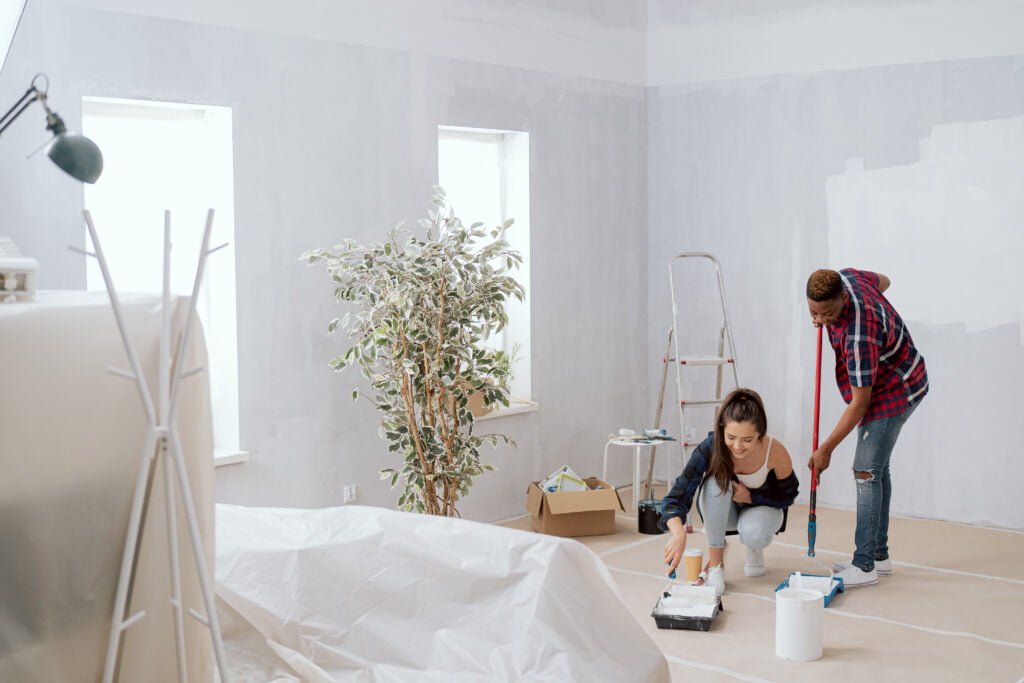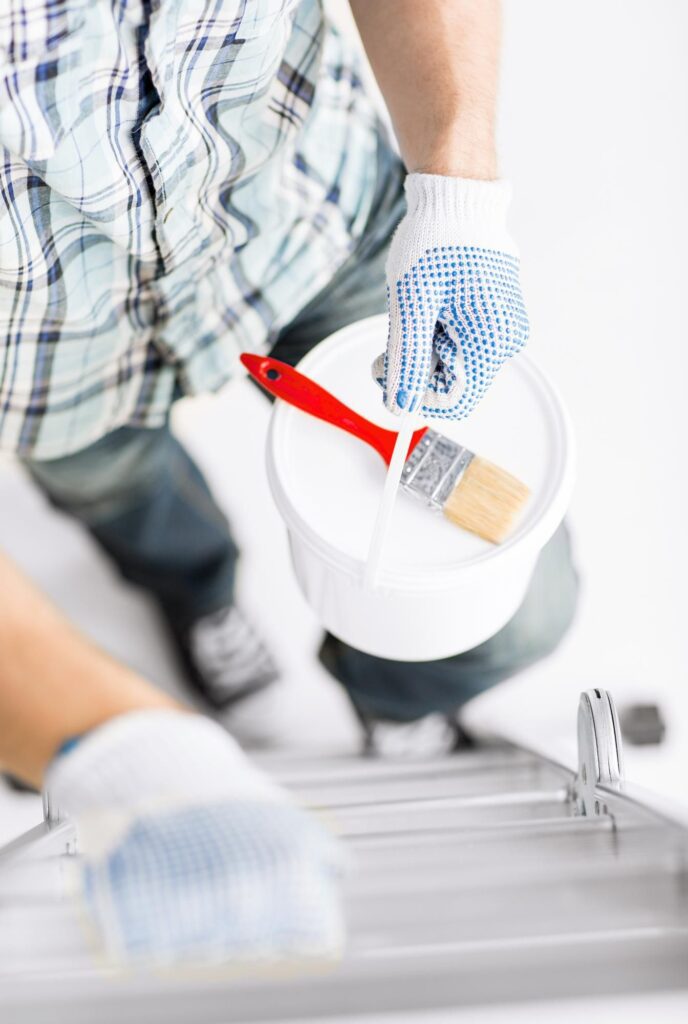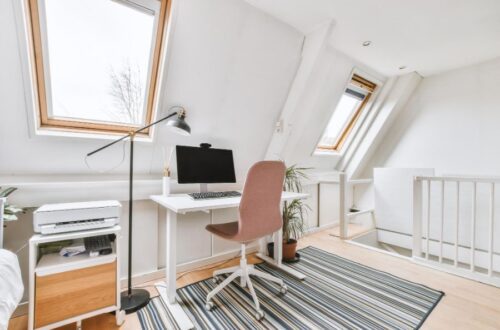5 Tips to Make Painting your Home Easier
Are you looking to freshen up your home with a fresh coat of paint, but overwhelmed at the thought of it? Painting your home doesn’t have to be an overwhelming task. With some careful planning and preparation, you can make this project much easier.
If you want to get the job done efficiently, the first step is making sure you have all of the necessary supplies beforehand. You’ll need quality paint in the shade and finish that you desire. You will also want to pick up some drop cloths for furniture and flooring. Another necessity is painter’s tape for clean edges on trim work. Get enough brushes or rollers for applying paint to walls or ceilings. It’s a good idea to have a ladder, if needed, for higher areas. Once everything is gathered together it will be time to start prepping the room before painting begins.

Tip #1: Properly Prepare the Wall
Before you start your home painting, it’s important to properly prepare the wall. You should remove any old wallpaper and repair any holes or cracks in the surface. You may also need to sand down rough patches or apply joint compounds for a smooth finish. Preparing your wall this way will ensure that your paint job looks professional and lasts longer.
How To Efficiently Prepare Your Wall Before Painting Your Home
Preparation is the most important step in the entire process. If you do not get the walls prepped correctly, your paint will likely show the imperfections. Don’t be afraid to ask for help with this step if you get in over your head. If you don’t have family or friends who are knowledgable in repairing and preparing to paint, you should consider contacting a professional handyman in Ada to make sure the job gets done completely and correctly.
- Remove any old wallpaper: removing any old wallpaper is the first step towards preparing your wall for home painting. Use a putty knife or steamer to scrape off the wallpaper and prepare it for paint.
- Repair any holes or cracks in the wall. Fill any holes or cracks with spackling paste or joint compound and sand them down until they are completely smooth.
- Sand down rough patches. If there are any bumps, ridges, or irregularities on your walls, you should give them a light sanding to create an even surface before you paint.
- Apply a primer: after you’ve prepared your wall, it’s time to apply a primer. Primers seal the surface of the wall and provide a blank canvas for your paint job.
- Sand the primer smooth. Once you’ve applied the primer, give it a light sanding to make sure that it is completely even and smooth.
Tip #2: Choose the Right Supplies for Painting Your Home
Choosing the right supplies for your home painting project is key to making sure that your paint job looks professional and lasts longer. You should use high-quality brushes, rollers, and paints to ensure that your paint job looks great. Make sure to select the appropriate type of paint for the surface you are painting. Different surfaces require different types of paint. For example, if you are painting wood, you should use oil-based paint. If you are painting drywall or plaster, you should use latex-based paint.
Choosing the right supplies will ensure that your paint job looks professional and lasts longer. High-quality paints, brushes, and rollers will make the process easier and provide better coverage. By choosing the appropriate type of paint for the surface you are painting, you’ll also be able to get the best possible results.

Tip #3: Use Dropcloths
Using dropcloths is an easy way to keep your floors clean during a painting project. Dropcloths are made of durable material and can be easily moved around as needed. They come in different sizes, so choose one that fits your space best. Be sure to tape down your dropcloth at all openings. This will prevent any paint from dripping onto your floor or furniture.
Using drop cloths will help keep your floors and furniture clean during a painting project. They can also be used to protect the surfaces of walls that are not being painted, such as baseboards or window trim. Dropcloths provide an extra layer of protection against paint splatters and drips, which can make cleaning up much easier.
Tip #4: Tape Edges and Trim
When painting walls, it’s important to tape off any edges or trim that you don’t want to get paint on. Use painter’s tape to mask off areas such as door frames, windowsills, baseboards, and ceiling lines. You should also use masking tape when painting trim or other detailed areas.
Taping off edges and trim will help to ensure that your paint job looks professional and clean. It’s also important to use the right type of tape; painter’s tape is designed for use on walls and other surfaces, while masking tape is better suited for more delicate surfaces such as trim or window frames. Taping off these areas will keep them clean and prevent any accidental spills or splatters from ruining your paint job.
Tip #5: Clean Up Your Brushes After Painting Your Home
When you are finished painting, be sure to properly clean your brushes and rollers with mild soap and warm water. This will help preserve the life of your painting supplies and ensure that they are ready to use the next time you need them.
Properly cleaning your brushes and rollers will help to extend their life and make them easier to use the next time you paint. It’s also important for health reasons, as leftover paint can harbor bacteria if it is not properly cleaned off of your tools. Cleaning up after yourself is an important part of making sure that your painting project goes smoothly and looks professional when it’s finished.

Final Thoughts on Painting Your Home
Some other tips that were not mentioned are to prep the surface you’re going to paint, sand any rough areas, use primer when necessary, and take your time. Prepping the surface will help ensure that the paint adheres properly and that your end result is completely even and smooth. Sanding any rough spots or nicks in the wall before painting will also help make sure that your final product looks good. The primer should be used whenever you are painting over a dark color or if you are using a glossy finish on a porous material like wood. Finally, try to take your time while painting; rushing can lead to sloppy results, so it’s best to take your time and do it right.
These tips will help make sure that your home looks great after you paint it. With the proper supplies, preparation, and techniques, you’ll be able to easily transform your home into something beautiful. Get that house painted with Groovy Hues, your one-stop shop for all your painting needs. Visit them online or give them a call today to get started!







3 Comments
Pingback:
Pingback:
Pingback: